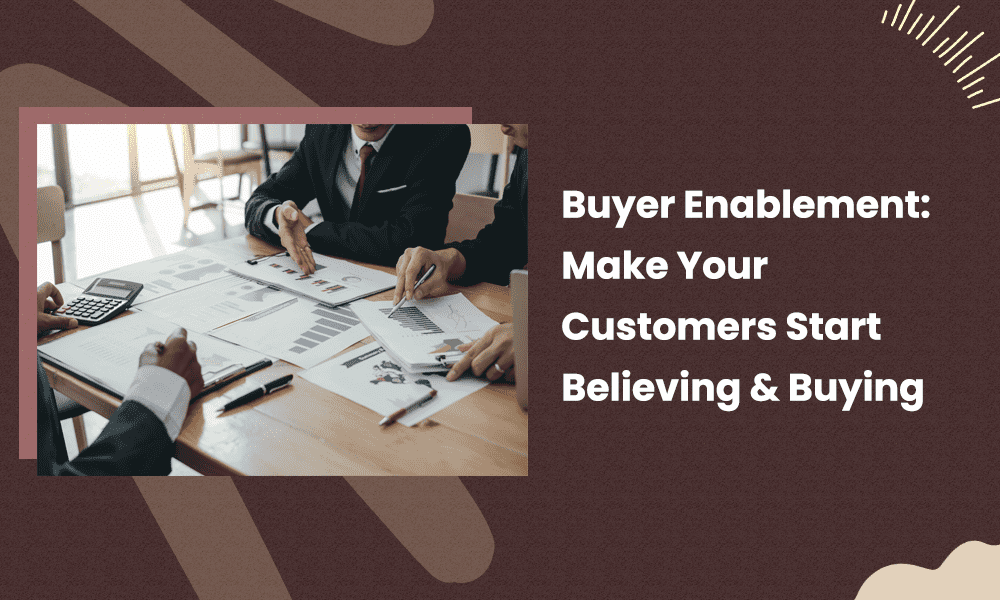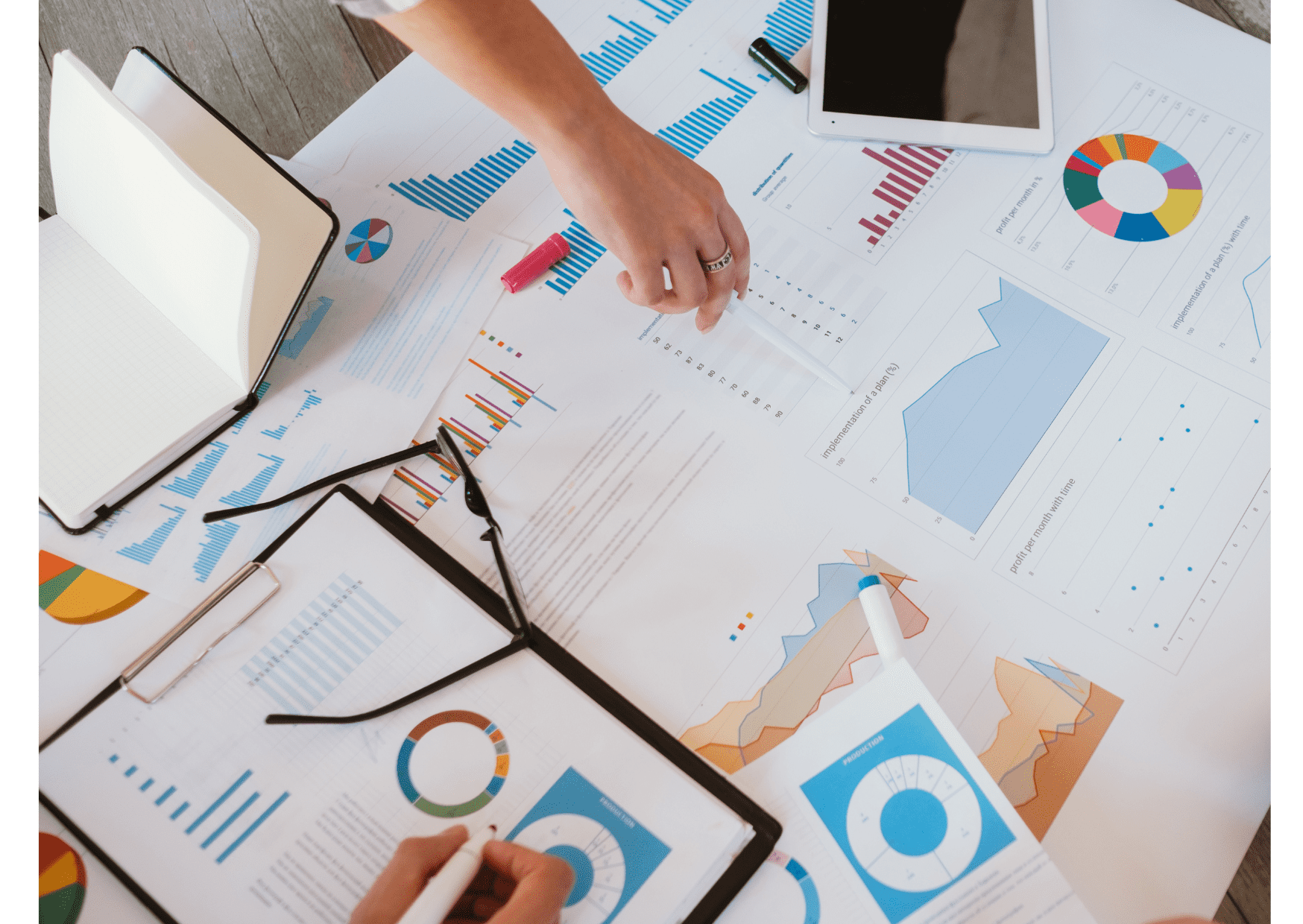Potential buyers who visit your website in search of solutions often have specific challenges they’re looking to overcome.
The question is, are you effectively communicating how your products or services can assist them in addressing those challenges? Are you providing the right content and information at the right time? Or are they already heading towards your competitor’s doorstep while you’re still waiting for a sales conversation to take place?
This is where buyer enablement comes into play. By implementing effective buyer enablement strategies, you can significantly enhance your conversion rates and even generate valuable word-of-mouth customer recommendations.
Buyer enablement can boost your conversion rates and increase word-of-mouth customer recommendations too.
In this comprehensive blog post, we’ll delve into the concept of buyer enablement and how it differs from traditional sales enablement.
We’ll explore the key components and best practices of buyer enablement, equipping you with the knowledge and tools to build your own successful buyer enablement strategy.
Throughout this post, you’ll gain a clear understanding of what buyer enablement entails and its distinct advantages. We’ll walk you through the step-by-step process of developing and implementing an effective buyer enablement strategy tailored to your unique business needs.
Additionally, we’ll highlight the crucial distinctions between buyer enablement and sales enablement, ensuring that you grasp the nuances and can differentiate between the two approaches.
By the end of this post, you’ll be equipped with actionable insights and best practices to optimize your buyer enablement initiatives.
Whether you’re a seasoned marketer, sales professional, or business owner, this blog post will serve as a valuable resource to unlock the power of buyer enablement and drive meaningful results for your organization.
Let’s dive in and explore the world of buyer enablement together.
Table of Contents
What is Buyer Enablement?
Buyer enablement is the process of helping buyers understand how to buy, use and get value from a product. It involves explaining the features, benefits, and value of a product or service.
This information is designed to help buyers self-drive, navigate the purchase process, and enable complete buyer enablement. The information may include diagnostics, online calculators, benchmarks, simulations, live coaching, and recommendations.
This process includes everything from helping buyers identify their issues to developing consensus with their collaborative stakeholders.
The Background
Traditionally, B2B sales strategies and technologies have been organized to enable sales teams in achieving their targets. The focus is usually on how to make more sales in less time – the standard route to revenue growth.
In contrast, buyer enablement focuses on buyer competence, the buying journey, and how to simplify the decision-making process. Where appropriate, this includes the benefits of technology to help stakeholders get what they need faster and in more enjoyable ways.
Enabling the modern buyer means supporting sales reps by providing content and insights to buyers throughout their journey. Helping your buyers get a fresh perspective in their buying journey will increase your chances of closing more deals, in less time.
How is Buyer Enablement Different From Sales Enablement?
Sales enablement helps sellers make more sales. Buyer enablement helps buyers make smart buying decisions. For example, arming buyers with every bit of information they may need to come to an informed decision.
This may include some practical support too, especially if you sell complex products or services.
Buyer enablement is a new concept in sales, and it’s gaining momentum with companies that want to boost their sales.
With this, companies create a single place where their customers can find information on how to use the product, how to get the most out of it, and anything else that would help them succeed.
Buyer enablement is different from traditional sales enablement because it focuses on helping customers reach their goals and not just selling more products or services.
Here are some key differences between buyer enablement and sales enablement:
Buyer Enablement – Helps customers get what they need from your organization, including information about products and services, pricing, fees, and other details. This is useful for long-term relationships with potential customers and also with customers who have already purchased from you once or twice.
Sales Enablement – Helps salespeople achieve their goals by providing them with tools for cold calling, lead generation, or closing deals quickly. This is useful for new customers who may not be familiar with your company yet or who need to be convinced before they buy anything from you.
How to Build the Perfect Sales Enablement Strategy
Examples of Buyer Enablement Content
There are many components of buyer enablement content, but the key ones include:
- Calculator – Provides a simple, structured way to analyze data
- Diagnostic – Provides customers with a useful framework for assessing performance or identifying their options
- Connector – Enables stakeholders to identify and establish common ground
- Recommender – Provides a clear, prioritized set of options in a particular purchase task based on customer inputs
- Advisor – Coaches customers through discrete purchase activities
- Benchmark – Provides customers with hard-to-find data for peer comparison
- Simulator – Demonstrates how the solution will work in the customer’s context
The cost-benefit analysis and ROI calculators are effective when targeting decision-makers, as they bring comfort and confidence to each stakeholder in the decision-making group.
Gartner says customers confident in their decision-making are 2.6 times more likely to buy more.
Read also: What Is Buyer Intent and How To Use It to Your Marketing Advantage?
Content Strategy to Help Buyers
Most content marketing efforts target lead capture and nurturing, which keep prospect buyers lacking critical information needed to make informed decisions.
The buyer enablement emphasized content writing should cover the following four areas.
How does your product solve the buyer’s problem?
Buyers usually look to fix their problems. Content aimed at clearly identifying how your product can solve a problem helps them make a decision.
Consumer surveys and interviews can combine potential customers’ pain points and what they are looking for.
What is your buyer’s intent?
Identify what factors go into a buyer’s decision to purchase your product. It may include cost comparisons, quality, service, offers, or features.
To gather more about your buyer’s intent, initiate online behavior-based activity that connects buyers and accounts to topics.
What types of content would be more effective?
In addition to written text, content includes infographics and other types of interactive content, as well as calculators that help buyers identify how the solution you offered benefits them.
Infographics, for example, are an ideal medium for data presentation, and video content illustrates visual benefits. In our buyer enablement web pages for potential users to compare EngageBay with other tools, we try to keep things super simple and easy on the eyes:
What is a suitable design?
Apart from visually appealing content, making the design shareable and easy to access can reach the buyer group and meet the emotional needs of your buyer.
Sales Tools, Tips and Strategies for Closing Deals
How to Build a Buyer-Enabled Content Strategy
A buyer-enabled content model is a roadmap for creating the right content at the right time, to support your marketing and sales teams in their efforts to build trust and credibility with new prospects, nurture leads through their buying journey, and ultimately convert those leads into paying customers.
You can create a buyer-enabled content model using the following six steps:
1. Define your buyer personas
Identify your target audience by identifying key characteristics — demographics, psychographics, purchase behavior — they share in common. Identifying these characteristics will help you deliver relevant content that resonates with each persona.
2. Prioritize topics for buyer-enabled content creation
Based on what you know about each persona, prioritize topics for buyer-enabled content creation that align with their needs and interests at different stages of their buying process.
3. Create a content pipeline calendar with defined milestones for buying stage
A calendar helps you plan ahead so that you’re always creating new or updated content at the right time during your prospects’ journeys from awareness to purchase decision (or whatever stage they’re in).
4. Focus on creating buyer-enabled content that addresses a need or problem
Your buyer-enabled content should address a pain point or need that the potential buyer has identified as important to their business. For example, you might create an educational piece about how to effectively measure ROI for social media campaigns.
This piece would help your buyer understand how to measure ROI for their efforts, and it would also give them a tool they can use to do so.
Also, you could create an infographic that outlines the different types of ROI metrics that are available. This would be helpful for someone who needs help understanding what kind of data is available and how to use it.
In addition to creating content, you can also create tools that help the potential customer do something with ease.
For example, if you are creating an infographic about ROI metrics, you could also create a calculator that automatically calculates ROI for different social media campaigns based on the inputs provided by the user.
This would be incredibly helpful because it allows people to quickly get their answers without having to do any sort of manual calculations themselves.
5. Create a persona landing page
Once you have the content and tools ready, it’s time to create a landing page for every buyer persona. This will be where people go to learn about the different types of content that are available to them.
More than making a sale right away, the goal of your landing page is to get people to sign up for your email list.
This will allow you to communicate with them on a regular basis and send them updates about new content that you’re creating.
It also gives you the opportunity to build relationships with these individuals so that when they do need help with their social media strategy, they will already have an idea of who can help them out.
6. Creating your email marketing plan
The best way to use email marketing is by sending out a weekly newsletter that highlights the content you’ve created for your audience.
This also gives them an opportunity to read about topics that they might be interested in learning more about, but haven’t yet explored.
Apart from highlighting your content, you should also make sure that you include a call-to-action in each email.
This gives your subscribers the opportunity to take action by visiting one of your landing pages or signing up for more information about what you have to offer.
8 SMART Sales Goals for Business Growth [+ Case Study]
Best Practices for Improving Buyer Enablement
Consider the buyer’s needs first
Creating a mindset aligned with buyer enablement starts with thinking about how you can put buyers’ needs first during your sales process.
Most sales organizations work to support salespeople, from channeling content requirements to field marketing to making decisions about investing in related functions in sales support.
Advise the buyers with no sales intention
Modern buyers rarely engage with sellers without doing their research. This suggests that the modern sales force spends less effort on educating buyers about the product and more on guiding them by engaging them in the buying process.
Engage with the buyers but don’t pester them
A flexible sales process frees buyers to make purchasing decisions as they wish. This option allows for a smoother buying journey, regardless of whether you have an in-house sales team or leverage outsourced SDRs.
Review the process you follow for any hurdles and hoops that may make it difficult to connect buyers to your business operation.
It can be as simple as avoiding the mention of a product demo on the first call or making sure there is no clunky handoff between a sales development rep and an account executive. If there is friction anywhere in your sales process, remove it.
Read also: Buyer Persona: The Ultimate Guide to Get Started
Wrapping Up
“The reason it seems that price is all that customers care about is that you haven’t given them anything else to care about.” ~ Seth Godin
In today’s competitive business landscape, taking care of your customers goes beyond mere transactions.
It’s about empowering them with the tools and resources they need to make informed buying decisions during the buying process. Buyer enablement is the key to achieving this, and EngageBay is here to help you excel in this area.
EngageBay offers a comprehensive suite of integrated sales and support tools designed to enhance your marketing efforts and enable your customers’ buying power.
By leveraging EngageBay’s powerful features, you can effectively engage with your audience, nurture leads, and provide exceptional support throughout the entire buying journey.
In a world where buyers are more discerning than ever before, traditional sales tactics fall short. Instead, the focus should be on delivering well-designed and relevant information that guides your customers through each stage of the buyer’s journey.
EngageBay equips you with the means to create personalized and targeted messaging, ensuring that your customers receive the right information at the right time.
With EngageBay, you can automate various aspects of your marketing and sales processes, saving time and resources while maintaining a consistent and engaging customer experience.
By streamlining your workflows and leveraging data-driven insights, you can optimize your strategies and maximize your chances of success in a competitive marketplace.
Remember, the key to winning in today’s environment lies in building strong relationships with your customers based on trust and transparency.
EngageBay’s buyer enablement tools provide you with the means to nurture these relationships effectively. By empowering your customers and providing them with the information they need, you position your brand as a trusted advisor, fostering loyalty and long-term success.
In conclusion, to thrive in a competitive marketplace where customers cannot be fooled, it’s crucial to prioritize this kind of enablement. EngageBay is your partner in this journey, offering a comprehensive suite of integrated sales and support tools to help you market your products and services effectively.
By focusing on providing well-designed and relevant information throughout the buyer’s journey, you can establish strong connections with your customers and achieve sustainable growth.
Trust EngageBay to empower your enablement efforts and drive meaningful results for your business.





